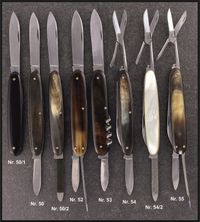75 mm
Victorinox developed the series of 75 mm pocket knives in the 1920s, originally with a length of 76 mm. Over time, a large number of very different models with many variants of scale material were created. Victorinox gradually took individual models out of production. From the 1950s only models No. 50 and No. 52 were produced. In the 1970s, Victorinox stopped production altogether.
This product line underwent various changes. Two different variants were created within the product line. Variant 1 was described as the "cheap version" (cf. cat. 1936). Within this variant there were two subdivisions. Pocket knives with single-colored celluloid/ cellidor scales in red or white were only available with carbon steel, while pocket knives with handle scales made of imitation ivory or imitation tortoise scale were consistently made of rust-resistant ( inox ) steel. This should underline the higher value.
In 1936, variant 1 pocket knives cost retailers between CHF 0.92 in variant no. 50, single-colored celluloid, without frame, carbon steel, to CHF 1.23 in variant no. 50 ivory/tortoiseshell with rust-resistant steel. An additional bail cost CHF 0.05 more per pocket knife. Variant 1 was only available for models no. 50 and no. 50/1 (cf. Kat 1936).
Variant 2 were considered to be the higher quality pocket knives. Only stainless steel was used. Horn, tortoiseshell, mother-of-pearl and black oxidized or guilloched steel were used as the scale material. In addition, handle scales with celluloid/ cellidor in imitation mother-of-pearl were also counted among the high-quality pocket knives. The price difference is also amazing. In contrast to model no. 50 in imitation ivory (price CHF 1.23), the one in imitation mother-of-pearl cost CHF 2.10, which resulted in an additional purchase of CHF 0.87 (cf. cat. 1936).
The price range of Variant 2 ranged from model no. 50 with black oxidized steel scales at a price of CHF 1.65 to the model with Jris grip scales (mother-of-pearl divided) at a price of CHF 3.45.
An additional hanger cost CHF 0.10 extra. There were also models with horn or mother-of-pearl handles, which also came with toothpicks and tweezers. The surcharge for this was CHF 0.80 (horn) or CHF 1.25 (mother of pearl). For this extra price alone in the mother-of-pearl version, you could buy two complete pocket knives in Cellidor version no. 50/1 in one -color carbon steel (costs per piece: CHF 0.55).
Variant 2 was available in models no. 50 to no. 55.
This makes it clear that two different stakeholder groups should be satisfied in a targeted manner in marketing. The target group for the "cheap version" was probably students and low-income people, while the "high-quality" version appealed to the middle to upper classes of society. This could/should then also pay double the price for an additional hanger (CHF 0.10 to CHF 0.05).
Over time, the marketing was adjusted and only pocket knives were offered in a high-quality version. Pocket knives with single-colored cellidor scales disappeared completely, as did carbon steel.
From the wide range of pocket knives in 75 mm, the models no. 50 and no. 52 are mainly found on markets and on auction platforms today, mainly with scales in Cellidor, engine-turned steel, horn and mother-of-pearl, mostly without a frame. The model no. 50 and no. 50/1 can also be found with aluminum scales, which were also produced for a certain period of time.
The variants No. 53, No. 54 and No. 55 are rarely found. And it is almost impossible to find any variants with scales in Jris or black oxidized.
This wide range of options for the customer to choose from certainly also had disadvantages in production. The increase in automated processes within the company certainly meant that certain models and variants were gradually no longer produced and only a few models in certain variants were established.
